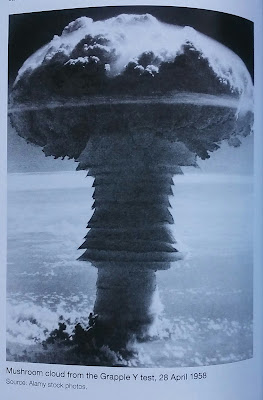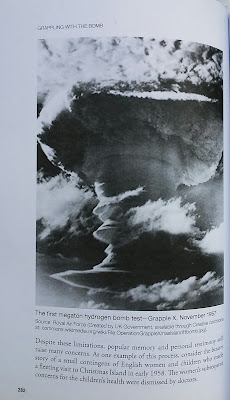- Book review -
The book's structure is original, effective and readable,
combining the best features of journalism (its author's profession), history
writing and presentation of research findings. As the titles of its chapters
indicate, it is first and foremost concerned with people, from the distant
decision-makers to the all too close participants in the test, above all the
large number who were adversely, often catastrophically affected by them.
This includes a wide variety of individuals and groups,
among them some who tried to stop the tests and many who struggled for some
semblance of justice in their aftermath. Here they often speak in their own
voices, to an extent unusual in historical or scientific accounts, although not
for the first time - interviews by Nic Maclennan with Pacific islanders were
published in an earlier book, and much testimony has been recorded in the
course of the long battle for 'compensation' to have their sufferings
acknowledged. A major factor in hampering their quest, compounding the harm,
has been the failure of the authorities to keep records of their exposure to
radiation, or to destroy any that existed.
“Over 50 years, the Western powers used the Pacific
region as a laboratory for nuclear testing.”
France was
not of course the only or the first country to inflict damage on other places
and peoples in the course of developing and testing nuclear weapons - and
arguably far from the worst, although its resumption of the programme in the 1990s
made it for a time the main focus of protests.
"Britain
tested nuclear weapons in Oceania between 1952 and 1958. There were 12 atomic
tests at the Monte Bello Islands, Maralinga and Emu Field in Australia
(1952–57). These were followed by nine hydrogen and atomic bomb tests in
1957–58 at Malden Island and Christmas (Kiritimati) Island in the British
Gilbert and Ellice Islands Colony (GEIC)—today the Republic of Kiribati." - Preliminary pages, p.xv in:
Nic Maclellan, Grappling with the Bomb: Britain’s
Pacific H-Bomb Tests. (Pacific Series). Australian Nation University (ANU)
Press, 2017. ISBN (print): 9781760461379/ ISBN (online):
9781760461386.
Download free https://press.anu.edu.au/node/2626/download
(5.0MB HTML, Mobile 5.8, epub 5.7.)
Buy Print $55 (£41.91 new via Amazon)
An extraordinary and important new
book published last year in Australia records, documents and comments
on the devastating effects of what Britain did in the late 1950s on and to
Malden Island and 'Christmas' (Kiritimati) Island in the Pacific.
 |
| See download for larger-scale maps |
In each chapter, however, there is much more than
biographical detail and anecdote. Memory, admittedly fallible, is supplemented
by solid contextualisation and correlated with well-documented back-up
evidence. For the non-scientist or non-historian, the relevant facts are
presented in a straightforward, accessible way. The book begins with a
time-line and glossary; 'interludes' expand on the key issues, and the
extensive bibliography is helpfully arranged by subject (including American and
French atomic tests) and type of material. And there are some striking and
terrifying pictures.
A campaigning work, it presents a comprehensive indictment of British
government meanness, bad faith and abdication of responsibility for those whose
world was taken over and whose lives were irrevocably damaged and shortened for
the sake of preparing even more damage and
destruction.
As we mark the 60th anniversary of the Grapple
tests in 2017–18, the issues of British nuclear weapons, indigenous rights and
a nuclear-free and independent Pacific are still with us.
There are debates in the UK parliament about the
cost of renewing Trident, the heart of the UK nuclear arsenal. Post-Brexit,
Scottish nationalists are calling for a nuclear-free and independent Scotland
as they move towards a second referendum on independence. The Republic of the
Marshall Islands—unsuccessfully—has taken Britain and other nuclear weapons
states to the International Court of Justice (ICJ) over their failure to meet
disarmament obligations under the Nuclear Non-Proliferation Treaty.
As a consequence, in February 2017 Britain withdraw from the
compulsory jurisdiction of the ICJ on matters of nuclear disarmament,
in order to halt further cases that threaten its nuclear arsenal.
Eight Pacific island countries co-sponsored the
December 2016 UN General Assembly resolution to establish a treaty banning
nuclear weapons, with negotiations amongst 130 governments commencing in March
2017. The South Australian Government is seeking to establish a nuclear waste
dump on Aboriginal land, even as the Australian Government exports uranium to
fuel nuclear reactors like Daichi Fukushima, which since 2011 has continued to
contaminate the land and marine environment. Meanwhile the Tokyo Electric Power
Company is wondering who will pay the horrendous price tag—US$160 billion
and counting—to clean up the world’s latest nuclear sacrifice zone at
Fukushima. The list goes on …
Even as some pundits call for an expansion of the
nuclear industry to address the challenge of climate change, we have not addressed
the costs and consequences of nuclear activities in the 1950s. As we enter a
new era of uncertainty, following the Brexit referendum and the election of
Donald J. Trump as US President, it is important to remember the tragedy of the
nuclear era in the Pacific, so we are never forced to repeat it.
Moreover, it is time for the citizens of the
United Kingdom to call on their government to do the right thing and address
the legitimate claims of the Grapple survivors.
- Introduction, p.16
A longer and more academic review of Grappling with the Bomb is available online (June 2018). Journal: Medicine, Conflict and Survival, vol.34, no.2.
Link for e-prints (free for the first 50) here.







No comments:
Post a Comment